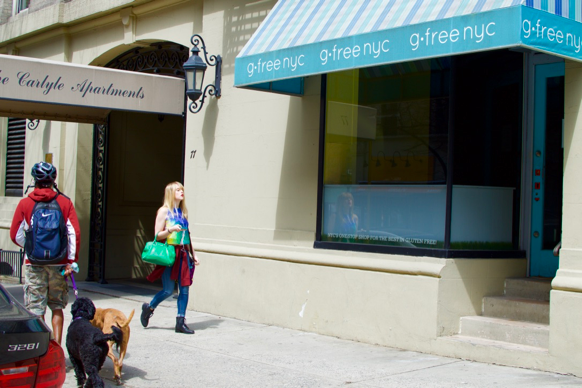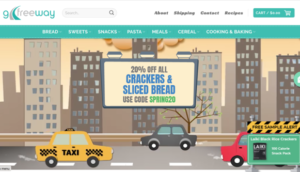
The awning of the former G-Free NYC on West 85 Street and Columbus Avenue. This storefront, along with nine others nearby, now sits vacant. Photo: Lynn Fantom.
When Lynn Shuter opened G-Free NYC in the spring of 2011, Florence Fabricant of The New York Times, along with press and food bloggers throughout the city, covered the news. The cozy shop, with its turquoise striped awning and butcher block table display, was the first store in Manhattan devoted exclusively to gluten-free food, a destination for celiacs seeking artisanal and gourmet specialties.
Last December, Shuter closed the shop and launched a website called GFreeway to replace it.
Shuter’s marketing acuity drove this decision. In the 1980s and 90s, she was on the frontline of ad sales for MTV, Nickelodeon and the Hallmark Channel, as cable advertising overtook network TV spending. Now, at 56, she has turned to e-commerce to serve her customers better.
Shopping online has taken a bigger and bigger bite out of in-store retailing. Forrester, the Cambridge-based research firm, projects it will account for 16 percent of overall U.S. retail sales by 2021, continuing a dramatic rise from 1.4 percent in 2001 to 11.7 percent in 2017.
Still, Americans have not adopted online grocery shopping as quickly as their counterparts in the U.K. and Japan, except for one category: specialty foods. E-commerce accounted for nearly 36 percent of sales in 2016, according to the Specialty Food Association.
That’s GFreeway’s niche. Shuter, who has a gluten sensitivity, sources from family-owned bakeries, food shops, and people who reached out to her as her reputation grew. Almond cakes hail from southeastern France, butter biscuits from Italy, and protein bars— created by self-described nutrition geeks—from Seattle. “And I’ve tasted it all,” says Shuter.
Specializing in artisanal food has helped Shuter stand out. Fairway Market, a competitor both online and on the Upper West Side, tends to carry mass-market gluten-free brands owned by the major food companies: Udi’s and Glutino (subsidiaries of Pinnacle Foods), Van’s (Tyson), and Applegate (Hormel).
The new GFreeway website organizes offerings into seven categories: bread, sweets, snacks, pasta, meals (including pizza), cereal and cooking/baking. What’s selling really well online, Shuter says, is bread (“it’s not cardboard tasting”) and snacks, such as cheese straws and snackers (like gourmet Goldfish, at $6.99). Because all products are frozen or shelf-stable, Shuter avoids one of the key barriers in online grocery: 67 percent of those who haven’t shopped for groceries online say it’s because they want to choose fresh items themselves, according to the market research company, NPD Group.
Consumers also demand transparency—about ingredients, production processes, and supply chains, says market intelligence agency Mintel in its report “Global Food & Drink Trends 2018.” People who suffer from celiac disease are even more concerned about the safety and purity of the food they buy. GFreeway makes it easy for visitors to find products that are free not only of gluten but of dairy, eggs, nuts, soy, corn, and oats. In her shop, Shuter was always ready with a magnifying glass to help customers scrutinize labels. Now, they can simply check off certifications, like nut-free facility, non-GMO, kosher, and FODMAP and then search.
But customer service — the personal touch — can be a challenge for small business owners who launch online. Yelp reviewers raved about Shuter’s recommendations and cooking tips. Julie R. from East Harlem in 2016 said that if you’re gluten-free, “you know how priceless these tips are.”

Owner Lynn Shuter has embraced social media to promote the new website. Photo: Courtesy of Lynn Shuter.
Shuter has substituted Instagram postings, a weekly newsletter, and recipes on the site (in which she hyperlinks to the ingredients she sells). The samples on the butcher block table have been replaced by single-serve packages provided by manufacturers. “I’ve learned through testing that people want my advice,” Shuter says. “A few weeks ago, in an email blast, I mentioned three of my favorite breads.” Those items got an immediate sales boost.
Erik Huberman, 31, CEO of Hawke Media, a digital marketing agency based in Santa Monica, California, says, “Some companies going from retail to e-commerce are naïve. They expect much higher margins because they are cutting out rent, but that cost is traded with a new cost, marketing. Without marketing, it is very hard to attract customers. It takes more than just putting up a website.”
Shuter’s commitment to “following the eyeballs,” means that she’s traded high retail rent for increased marketing costs. “It’s a whole different ball game,” Shuter says.
She had been paying $3,800 in monthly rent for 250-square-feet. She swapped out rent for the costs to warehouse her inventory, pick and pack each order, host and manage the website, and send customers emails. Altogether, those new expenses amount to around $1,600.
So, costs are down, but sales volume is down, too. Shuter used to get 30 or 40 walk-ins at the store every day; now that’s her weekly traffic.
“I need more marketing,” she says. Once she has ironed out some delivery kinks, she’ll focus on improving GFreeway’s search engine rankings and will test paid Google ads.
Google AdWords estimates that a $1,100 monthly campaign to buy keywords such as “gluten free,” “gluten free bread,” and “gluten free snacks” would yield 9,500 clicks to GFreeway. And, if 10 percent of those visitors purchased (that’s the estimate from MarketingSherpa’s Ecommerce Benchmark Study 2014), GFreeway would have 950 sales—all likely new customers.
What gets Shuter excited is that with a Google AdWords campaign, she only pays for clicks to her site. And she can start with a small ad buy to see how it works. Even with that hypothetical $1,100 investment in ads, she still would have brought her expenses down by almost 30 percent to get the same sales she had in her shop.
Meanwhile, nine storefronts sit empty in the two-block radius around Shuter’s former shop off Columbus Avenue at West 85 Street. Prices are softening now, according to Jason Pennington, 45, of Ripco Real Estate, which has several retail vacancies in the neighborhood. Last fall, in its Manhattan Retail Report, the Real Estate Board of New York acknowledged that “this is an environment for price discovery in a market that is still learning about the effects of online retailing.” Helping to lower real estate costs could be Shuter’s parting gift as she takes off for cyberspace.


Your Comments